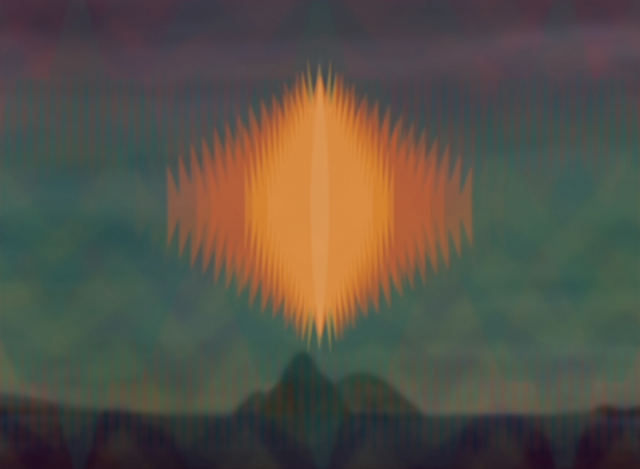 |
| Katarina Löfström, A Void, 2013, image: Katarina Löfström |
In Katarina Löfström’s third solo exhibition at Andréhn-Schiptjenko, one is cajoled by both the comfort of repetition and sensory parameters related to any given reality. Perception, after all, is adaptable and even, at times, restrained. Human beings are able to train themselves to hone attractive skills and master talents through trial and error. Yet we are limited by the physical vessels we inherit, and hindered as our bodies deteriorate over time. As if in response to these constraints, Löfström focuses inward, embracing less circumscribed states—to begin the dialogue between “me” and “myself,” which Plato saw as the essence of thought.
When moving through the space, I found my breathing slowing down—I felt myself slowing down—as if the artist was inviting me to feel no shame in taking refuge in what is provided. Low, ambient sounds drone from the video A Void (2013), reminiscent of Robert Fripp & Brian Eno collaborations or soundtracks from sci-fi films such as Stanley Kubrick’s 2001: A Space Odyssey (1968), minus the paranoia. When viewing Löfström’s consciousness-expanding collage works (on view alongside the video), no text is displayed in association or clarification and no parameters are defined, persuading one to develop a language based solely upon images. With this lack of linguistic signs or signifiers, the viewer must move through the image to access communication—and there is no way around this trajectory for Löfström. She highlights that which cannot be said or expressed via conventional language or the practicality of speech: the incomprehensible, uncharted, evolving.
It is useful to question whether or not one can construct an alternative language without referring to other languages. Gertrude Stein’s “A rose is a rose is a rose is a rose” reminds us that a rose is always a rose, but with art, a rose is no longer a rose: it has been manipulated to become something else. The rose becomes what the artist (and viewer) wants it to become. But in the absence of textual references, Löfström provokes dissociative freedom. The viewer is not encouraged to pair up predictable text-image sequences or default relationships. Nevertheless there remains the question of how the collage series on view relates to the video installation itself: do these framed works merely function as marketable commodities—to be taken home, possessed—and do they carry the same weight without the accompanying video? Are they to remain together as a group or can they be viewed (and sold) individually? At least at first glance, the collaged images suggest stills from the video; they reveal the same “vitality globules” on the blurred horizon, but reiteration does not guarantee heightened significance.
If we turn to the press text, we learn that what we are witnessing is evidence of the Swedish artist’s investigations into entoptic phenomenon, that is, visual images specific to one individual and not necessarily guaranteed as replicable for others. But the illusions here are not always accessible by more than one person, for these entoptic images are created by a unique retina. Each entopic experience remains intimate—an image interpreted by one brain alone (and sometimes even considered a hallucination). The background images in Löfström’s video A Void were appropriated from both Walt Disney’s Saludos Amigos (1942) and the 1951 film version of Lewis Carroll’s Alice in Wonderland (1865). Coupled with 1960s psychedelic aesthetics—groovy forms hinting at altered consciousness and tapping into parallel worlds—both the video and collage works share glowing, rhombus shapes and leafy arrangements, reminiscent of hypnosis tactics. In the video, instructions such as “Visualize a red triangle inside a blue square suspended in darkness,” are typical meditative imperatives associated with cognitive games that emphasize the significance of the blank slate.
Much can be gained from embracing the void—the ability to locate clarity, reassess priorities, find or question meaning, create new languages. Further, one cannot always be in motion; we require pauses before moving forward to confront new tasks. Jean-Paul Sartre argued: “Everything which may be said of me in my relations with the Other applies to him as well. While I attempt to free myself from the hold of the Other, the Other is trying to free himself from mine; while I seek to enslave the Other, the Other seeks to enslave me.” 1 Between these power shifts and surfacing conflicts exists a vacuum; such time-outs are well-deserved.
Thought Form (Embracing Space) (2013) appears to be misplaced—perhaps, an afterthought in the exhibition, yet it is the first piece one encounters. This copper sculpture stands as one of the artist’s many site-specific interventions (though just one from the series is on view here) representing how thoughts and moods move in currents. Since it is the first piece we encounter when entering the gallery, it serves as counterpoint to the monism of the otherwise hallucinatory phenomenon on view. If by exposing the pipes that would have been hidden behind the wall, the myth of the interior versus exterior collapses, all becomes equal. This particular equity (or lack thereof) is challenging to unpack, especially in the context of entoptic phenomena—can the rose remain the rose? Can A remain A? Is A ever congruent to B? What is gained or lost when my A refuses to be your B?
(1) Jean-Paul Sartre, Being and Nothingness (New York: Washington Square Press, 1984), 474–475.
To see the review in context, click here.








